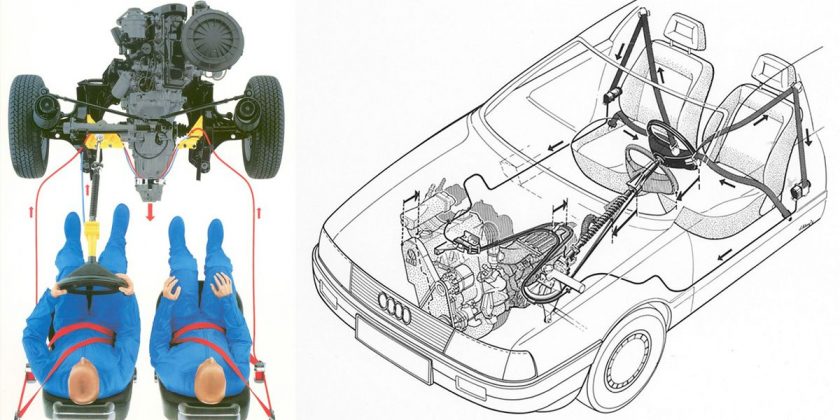The airbag had started to emerge in the early 1980s, starting inside Mercedes-Benz cars and quickly spreading to models made by all other German brands except Audi. Audi had an engineer called Elmar Vollmer, who with his admirable German sensibilities took time to analyse this new inflate-o-face-saver and felt that these early models just weren’t reliable enough: sometimes they didn’t actually inflate. This was improper for a future, ultra-safe Audi, thought Herr Vollmer.
He wanted something fail-safe. Something mechanically driven, whereby a severe frontal impact physically couldn’t fail to actuate the safety systems. He came up with a remarkable and bizarre arrangement where the steering column and seatbelt pretensioners were hooked, via heavy-duty steel cabling, to the back of the gearbox. It was called Procon-Ten. In true ‘80s style it sounded like something out of Buck Rogers but it actually stood for Programmed Contraction and Tension.

As you probably already know, in those days Audi mounted all of its engines longitudinally, engine block in front of the front wheels and the gearbox extending out behind it. A cable was routed cleverly around the steering column base and the gearbox, meaning that when the front of the engine was pushed backwards, the cable simply yanked the column out of the way while at the same time firing the seatbelt pretensioners to keep occupants pressed back in their seats.
Hey presto; no airbag reliability issues and, in theory, no chance of large-scale blunt force torso or facial trauma. It wasn’t quite that simple, naturally, with even Audi’s own photographs of the system seeming to display a steering wheel only retracting as far as a person’s knees – and right above the kneecaps, at that. If you’re wondering at this point whether it would be better to smash your knees rather than your face, there really are no winners here.
Procon-Ten was introduced in 1986 after a number of years in development. It was, and remains, a unique design, finding its way into Audi’s 100 and 200, plus certain high-spec 80s and 90s. Functionally it was brilliant, insofar as protecting faces went, but all that beefy engineering was heavy. Ever tried lifting a reasonable length of steel cable?
Audis really didn’t need any extra flab at the front end, and as airbag designs became more efficient and reliable, Precon-Ten was phased out in favour of the blow-up solution we know and love today. The sheer engineering complexity of it, now that most cars use transverse engines, versus simply whacking a perfectly good off-the-shelf airbag design into a steering wheel means we’re not likely to see it again, either. Still, if nothing else it’s an interesting curio for the excellent Ingolstadt museum.
Source: Read Full Article

